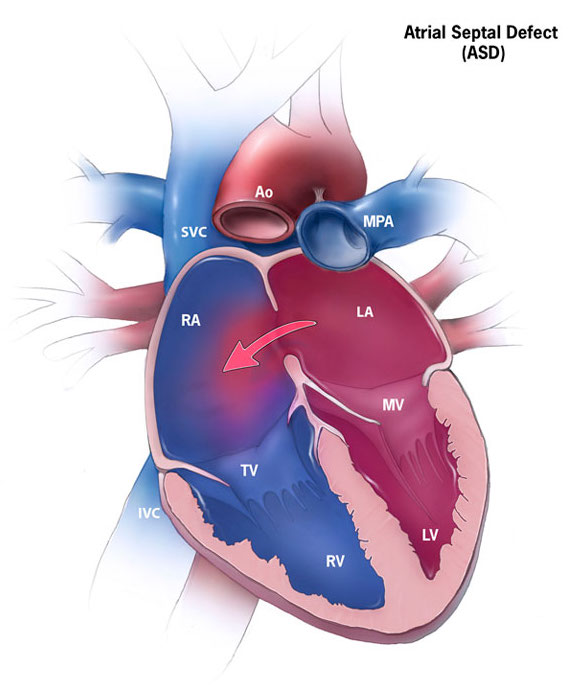Page Contents
OVERVIEW
This page is dedicated to organizing various examples of standardized exam questions whose answer is a atrial septal defect (ASD). While this may seem a odd practice, it is useful to see multiple examples of how a ASD will be characterized on standardized exams (namely the boards and the shelf exams). This page is not meant to be used as a tradition question bank (as all of the answers will be the same), however seeing the classic “test” characterization for a disease is quite valuable.

KEY CHARACTERISTICS OF THIS CONDITION (ON EXAMS)
When it comes to standardized exams, each condition has its own “code” marked by key buzzwords, lab findings, clues, etc. If you are well versed in this code you will be able to more quickly identify the condition that is being discussed, and get the right answer on the exam you are taking. Below is the “code” for ASD.
Chief Complaints:
- Often asymptomatic if patient does not have complication of ASD
- Stroke symptoms (weakness/aphasia/etc) if patient has a stroke that is a complication of the ASD
Patient History:
- Mysterious stroke: such as a stroke in a young patient with a DVT
Patient History:
- Physical Exam Findings:
- Systolic murmur: heard best at left sternal border (due to increase flow across pulmonary valve)
- Split and fixed S2: can be also described as “wide”. P2 always closes after A2 because of increased flow through the pulmonic valve.
- Loud S1 can also noted on the exam
- Positive bubble study: echocardiogram with agitated saline injected in peripheral vein showing passing of bubbles into left side of the heart.
QUESTION EXAMPLES
Question # 1
A 22 year old woman comes to the clinic for a routine health checkup. Her vitals are all within normal limits. A physical exam is notable for a S2 sound that is split and fixed. A systolic murmur is heard at the third intercostal space during auscultation. The rest of the physical exam is unremarkable. What is this patient’s likely underlying diagnosis?
Explanation #1
Split and fixed S2 + systolic murmur (at left sternal border) = ASD
Question # 2
A 48 year old male with a 35 peace year smoking history develops right leg pain and swelling after a long flight back from Armenia. He is diagnosed with a lower extremity DVT, and is started on IV heparin. Shortly after being admitted to the hospital, he develops a right sided facial droop as well as weakness in his right hand. A CT scan of the head reveals an MCA stroke. What type of underlying condition could make this type of stroke possible?
Explanation #2
DVT + stroke = ASD (would allow for clot to travel from venous system in legs to the arterial system in the brain)
Question # 3
A 14 year old male is asymptomatic, but comes to the clinic for a routine physical. His past medical history is unremarkable and he denies using any alcohol or tobacco products. A physical exam reveals that he has a wide and fixed splitting of S2 on his cardiac exam. What congenital defect does this patient likely have?
Explanation #3
Wide and fixed splitting of S2 = ASD
Question # 4
A 40 year old female is brought to the ER after she develops a sudden right arm weakness. The patient also began suffering from difficulty speaking, which prompted her husband to bring her to the hospital. Her past medical history is unremarkable other then her prescription for oral contraceptives. A neurological exam reveals decreased strength in the right arm, and an expressive aphasia. The patients respiratory exam is unremarkable. An MRI of the brain diagnosis an acute stroke involving the left frontal lobe, with an unknown etiology. During an echocardiogram, normal saline containing saline is injected into a peripheral vein, and the bubbles are seen passing into the left side of the heart. What is the diagnosis in this patient?
Explanation #4
Positive bubble study (passing of peripherally injected bubbles into left side of heart) = ASD
TESTABLE FACTS ABOUT THIS CONDITION (BEYOND ITS IDENTIFICATION)
Many questions on standardized exams go beyond simply recognizing the underlying condition. Often there are specific testable facts regarding some aspect of the disease’s pathophysiology/management/clinical implications that are commonly asked. Some of these are listed below:
Cause:
- Mistake in development of heart: incomplete fusion of the atrial septum primum and secundum is responsible for causing this condition.
Complications:
- Chronic pulmonary hypertension can be caused by left to right shunting of the blood (can cause vascular sclerosis/Eisenmenger syndrome)
- Stroke: in the setting of a DVT, a cerebrovascular stroke can occur due to the ability of a clot to bypass the lungs and travel up to the brain.
Treatment:
- Surgery: the ASD can be surgically closed to prevent shunting of excess blood into the pulmonary vessels.
Page Updated: 04.07.2017